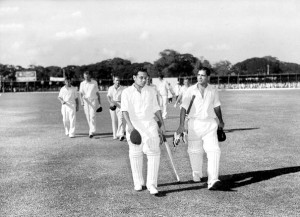Registered with the Registrar of Newspapers for India under R.N.I 53640/91
Vol. XXVI No. 10, September 1-16, 2016
When Tests were NOT played at Chepauk
by Partab Ramchand
partabramchand@yahoo.com

Indian Openers Pankaj Roy (left) and Vinoo Mankad, who put on a then world record 413-run partnership for the
first wicket, returning to the pavilion during the Fifth Cricket Test against New Zealand at the Corporation Stadium,
Madras, in 1956.
Cricket in the city is so inextriably linked with Chepauk (or M A Chidambaram Stadium) that it is sometimes difficult to remember that Test matches were played no there but at an unlikely venue – the Corporation Stadium, the site of the present Nehru Stadium – for nearly ten years in the 1950s and 60s. Chepauk had hosted Tests from February 1934 to December 1952 before the shift to the Corporation Stadium in January 1956 for the Test against New Zealand. The last Test played there, in February-March 1965, was also against New Zealand. In between India played seven other Tests – against the West Indies, England, Australia and Pakistan.
Just nine matches but there was action, records and historic events packed into them. The very first Test saw the famous 413-run first wicket partnership between Vinoo Mankad (231) and Pankaj Roy (173) which is arguably Indian cricket’s proudest statistical achievement on grounds of longevity. It stayed as a world record for 52 years before Graeme Smith and Neil McKenzie raised the bar to 415 for South Africa against Bangladesh in 2008. Incidentally, Mankad’s 231 was then the highest individual score by an Indian in Tests. India won that game by an innings and 109 runs, at the time their biggest margin of victory, after piling up 537 for three declared, then their highest total in Tests.
I also recall Hasib Ahsan’s marathon bowling for Pakistan in 1960-61. The off-spinner sent down 84 overs for figures of six for 202 as India piled up 539 for nine declared, setting a new record for India’s highest total in Test cricket. Also remembered is the fire that erupted in the eastern stands (they were makeshift thatched roofs those days) which caused play to be abandoned some 20 minutes earlier on the fourth day when a section of the spectators spilled on to the field of play.
The following season saw a historic event – India clinching their first series triumph over England. Having won the Fourth Test in Calcutta by 187 runs for a 1-0 lead in the five-match series, India duly kept its appointment with history by winning the Final Test by 128 runs, Salim Durrani’s ten-wicket haul being the highlight.
There was another world record set in the next Test played at the Corporation Stadium. Against England in 1963-64, left arm spin bowler Bapu Nadkarni sent down 21 successive maidens during England’s first innings on his way to the eye-rubbing, mind-boggling figures of 32-27-5-0. The following season saw the Nawab of Pataudi emulating his father’s feat of scoring a hundred in his first Test against Australia. The skipper’s knock was, however, in vain as Australia overturned a 65-run first innings deficit into a 139-run victory with Graham McKenzie having match figures of ten for 91. The major highlight of the last Test played at the Corporation stadium was an unbeaten 102 by Vijay Manjrekar in his last innings in Test cricket. But perhaps the biggest drama concerning Tests at the Corporation stadium was off the field.
Polly Umrigar, the appointed captain for the Fourth Test against the West Indies in January 1959, resigned the night before the scheduled start following a misunderstanding over selection matters. Parleys between Umrigar, senior players and Board officials went on throughout the night in an effort to get him to withdraw his resignation. But Umrigar remained adamant and, finally, a few hours before dawn Vinoo Mankad was appointed in his place. The spectators who knew nothing of the drama only saw the closing act – Mankad walking out with Gerry Alexander for the toss.
Incidentally many Indian players never played a Test at Chepauk, their international careers being restricted to matches at the Corporation Stadium. The list includes Vijay Manjrekar, Nari Contractor, Bapu Nadkarni, Ramakant Desai, M.L. Jaisimha, Budhi Kunderan and Naren Tamhane.

